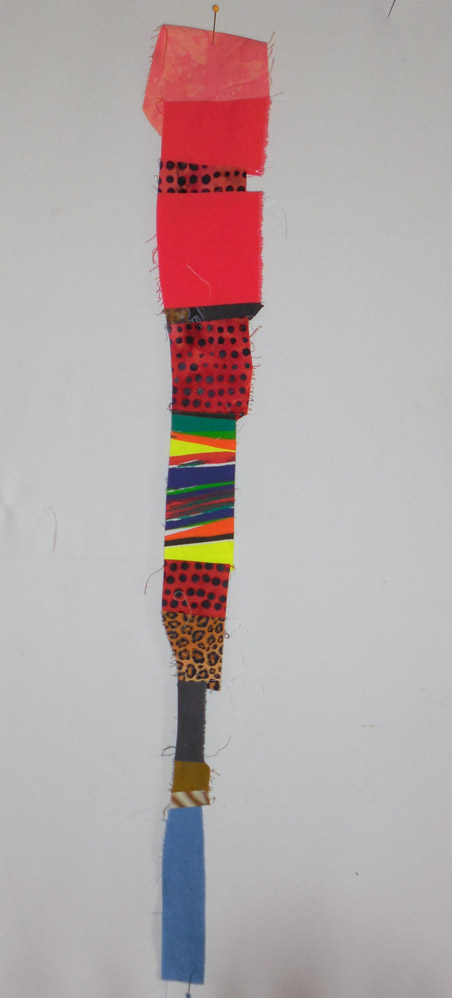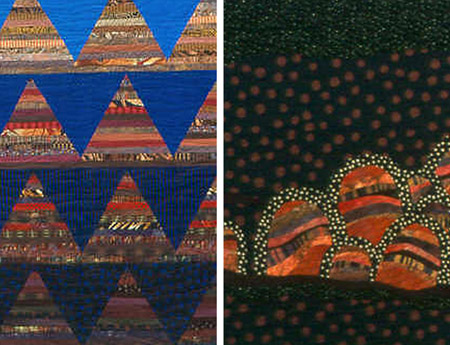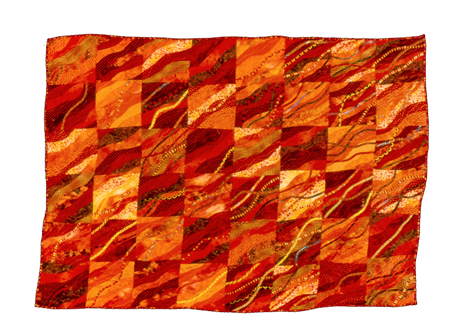I’m quite often asked how to go about improvisational or freehand (template free) cutting and piecing which has become very widespread among quilt makers in the past 25 years- a modern tradition really. Widely used by art quilt makers who piece their designs, and seen in quite a number of Modern Quilts, it’s all rotary cut and machine pieced. The following basic instructions contain all you need to know to begin, as I only learned it from watching a short demonstration by Nancy Crow at the start of a several day long workshop, and then plunging in to using it straight away. It enabled us to rapidly get through heaps of exercises in her class on design and colour. I’ve been enjoying this way of piecing ever since.
Hand piecers could use this just once, perhaps, to make some wayy lines in the one direction but it really is a machine technique, even if you’re pretty speedy, as hand sewing won’t allow for more complex cutting, re-arranging, inserting slivers and so on.
Freehand or ‘improvisational piecing’ has become a modern convention – and once you recognize it, you’ll see it wherever there are pieced art and non-traditional quilts. Elsewhere on this website are two galleries of my original quilts made between about 1990 and the present – the Color Memories gallery followed chronologically by the Ebb& Flow gallery. Keep in mind that have been piecing this way for over 20 years, but I too began with these simple instructions way back then. With practice, you too will be able to achieve more complex constructions if you wish.
The main things to remember are:
- to place both fabrics right side up
- without built-in seam allowances, as you cut and sew each fabric shape its area showing on front becomes progressively smaller – so start out larger in anticipation. Experience will tell you how much to allow, but, if you run short somewhere on a side you can always add another piece as quilters traditionally have !
- in addition to getting smaller, so, too, the edges become progressively more irregular. Resist your trimming urges until you have finished ALL the piecing. When you do get round to trimming, discard tiny pieces but keep anything useful – small bits also piece up into lovely freeform mosaics you could use for appliqued or printed designs – see Judith Trager’s work among others for some good examples.
Alicia Merrett ‘s YouTube videos, are good in a very precise, controlled way –but, they were pitched to careful traditional quilters, but even so, you might find them helpful. In the Nancy Crow class where I learned this piecing, we had a lot of colour and design work to get through in the time, and Nancy showed us these basics that enabled rapid working. We put all rulers away and did no pinning, just putting edge to edge and sewed. Some managed this better than others in the workshop; and at home I found my own way of working which includes periodic dots along the cut edges with permanent marker or other pen/pencil/chalk – and even more of these in tight curves. I usually pin every few inches, more in tight curves – but it all depends…. there are no right ways to do this, and only one correct result – a flat one. Once you have learned the basics, experience will teach you whatever you want to know next – think it, try it. And, if you ever need my advice or help, feel free to contact me through this website.





















